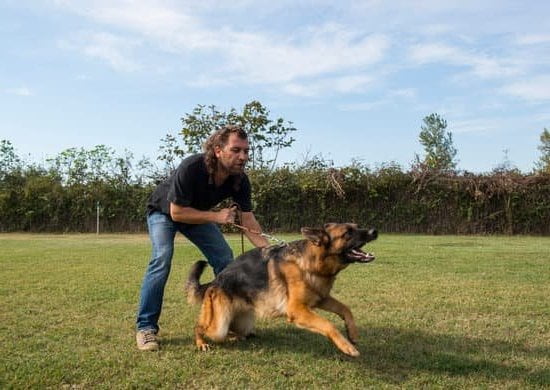Are you wondering, “How long does it take to leash train your dog?” Leash training is an essential skill for any dog owner and can greatly improve the safety and enjoyment of walks with your furry friend.
In this article, we will explore everything you need to know about leash training, including the basics, step-by-step guide, common challenges, and the importance of positive reinforcement. By understanding the importance of leash training for your dog, you can effectively set realistic expectations and achieve success in a reasonable amount of time.
Leash training is not just about compliance; it is also about safety. A well-trained dog that walks calmly on a leash is less likely to pull or dart into traffic or get into altercations with other dogs.
Additionally, proper leash training can make outings more enjoyable for both you and your pet, as it allows for a relaxed and pleasant walking experience. With the right approach and understanding of the process, you can ensure that leash training becomes a positive bonding experience between you and your dog.
In the following sections, we will delve into the details of leash training, offering guidance on overcoming common challenges and setting realistic expectations. From understanding the factors that affect the time it takes to leash train your dog to maintaining good leash behavior in the long run, this comprehensive guide will provide valuable insight for both new and experienced dog owners. So, let’s dive in and explore how you can successfully leash train your dog.
The Basics of Leash Training
Leash training is an essential part of owning a dog, as it allows you to have control when walking your pet and keeps both you and your dog safe. Before you start leash training, there are some basic things you need to know to ensure a successful training experience.
First, it’s important to choose the right leash and collar for your dog. The leash should be sturdy and the right length for your dog’s size. There are different types of collars available, such as flat collars, martingale collars, or harnesses. It’s important to choose the one that is most appropriate for your dog’s breed and behavior.
Another key aspect of leash training is understanding your dog’s behavior and body language. Dogs communicate through body language, so being able to read their signals can help you anticipate any potential problems during the training process. Understanding how your dog reacts to different stimuli will also help in addressing any challenges that may arise during leash training.
Lastly, before starting leash training, it’s important to ensure that your dog has had enough exercise and mental stimulation. A tired dog is more likely to be focused during training sessions, so taking your dog for a walk or engaging in playtime before starting the training will make the process much smoother. Keep these basics in mind as you prepare to start leash training your beloved pet.
Setting Realistic Expectations
Leash training your dog can be a rewarding but time-consuming process. The length of time it takes to leash train your dog can vary depending on several factors. One important factor is the age and breed of your dog.
Puppies tend to pick up leash training more quickly than older dogs, while some breeds may be more stubborn or resistant to leash training than others. Understanding these factors will help you set realistic expectations for how long it will take to leash train your dog.
Another important factor that affects the time it takes to leash train your dog is consistency in training. In order to achieve success in leash training, it’s essential for pet owners to be consistent in their approach and practice regular training sessions with their dog. Without consistency, progress in leash training can be slower and less effective, ultimately prolonging the amount of time it takes to achieve desired results.
Additionally, the individual temperament and personality of your dog play a significant role in how long it takes to leash train them. Some dogs may naturally be more anxious or easily distracted, making it more challenging to keep their focus during leash training sessions. Understanding your dog’s unique traits and characteristics will allow you to tailor your training methods accordingly, ultimately affecting the overall timeframe for successful leash training.
| Factors | Impact on Leash Training |
|---|---|
| Age and Breed | Varies – puppies tend to learn quicker; certain breeds may be more challenging |
| Consistency | Essential for effective training; lack of consistency prolongs the process |
| Temperament and Personality | Affects focus and attention during training sessions |
Step-by-Step Guide to Leash Training
Leash training your dog can be a rewarding experience for both you and your furry friend. It’s important to approach this process with patience, consistency, and positivity. Here is a step-by-step guide to help you through the leash training process, from getting your dog used to the leash to walking properly.
Getting Your Dog Used to the Leash
Before you begin actual leash training, it’s important to get your dog comfortable with wearing a collar or harness and being attached to a leash. Start by allowing your dog to sniff and inspect the collar or harness, and gradually introduce it for short periods of time. Once they are comfortable with wearing it, attach the leash for short periods while inside the house. Use treats and praise to create positive associations with the collar/harness and leash.
Introducing Walking Properly
Once your dog is comfortable with wearing their collar/harness and being attached to the leash, it’s time to work on walking properly. Begin by teaching them basic commands such as “sit” and “stay,” which will be useful during walks. When starting out, keep walks short and in quiet areas to minimize distractions. Encourage your dog to walk beside you rather than pulling ahead or lagging behind.
Practicing Consistently
Consistency is key when it comes to leash training. Make sure that every walk follows the same routine, with clear expectations for behavior. As your dog becomes more comfortable with walking on a leash, gradually increase the duration and introduce different environments and distractions. Remember to always use positive reinforcement such as treats, praise, and petting when your dog exhibits good leash behavior.
By following these steps and maintaining patience throughout the process, you can successfully train your dog to walk politely on a leash. Keep in mind that every dog is unique, so progress may vary based on individual personality, age, breed, and past experiences. With time and dedication, you can enjoy many happy walks with your well-trained pup.
Common Challenges and How to Overcome Them
When leash training your dog, it is common to encounter challenges such as pulling, distractions, and fear. These challenges can make the process frustrating for both you and your dog, but with patience and consistency, they can be overcome.
Dealing With Pulling
One of the most common challenges in leash training is dealing with a dog that constantly pulls on the leash. This behavior can be not only annoying but also dangerous if your dog pulls you into traffic or causes you to lose balance. To overcome this challenge, it’s important to teach your dog to walk politely on a loose leash.
One effective method is to stop walking whenever your dog starts pulling and only continue when the leash is loose. Consistency is key in reinforcing this behavior.
Managing Distractions
Dogs are naturally curious creatures, and it’s not uncommon for them to get easily distracted during walks. Whether it’s another dog, a squirrel, or simply an interesting smell, distractions can make leash training difficult. To overcome this challenge, it’s important to work on building your dog’s focus.
You can do this by using high-value treats or toys to redirect your dog’s attention back to you whenever they become distracted. Gradually increasing the level of distractions during training can also help desensitize your dog.
Addressing Fear
Some dogs may exhibit fear or anxiety when it comes to leash training, especially if they had negative experiences in the past. It’s important to address these fears with patience and positive reinforcement. Slowly introducing the leash and harness in a non-threatening way and associating it with positive experiences such as treats or playtime can help reduce fear and build confidence in your dog.
By understanding these common challenges and implementing effective strategies to overcome them, you can make the leash training process smoother for both you and your furry companion. Remember that consistency, patience, and positive reinforcement are key components in addressing these challenges successfully.
Positive Reinforcement
When it comes to leash training your dog, positive reinforcement is a crucial aspect of the process. It involves rewarding your dog for good behavior rather than punishing them for bad behavior. This method has been proven to be more effective in training dogs and creating a stronger bond between the owner and their pet.
Here are some key points to consider when implementing positive reinforcement in leash training:
- Use treats or verbal praise to reward your dog when they walk politely on the leash without pulling or lunging.
- Be consistent with your rewards and timing. It’s important to give the reward immediately after your dog exhibits the desired behavior so they can make the connection.
- Avoid using punishment or harsh corrections as this can lead to fear or anxiety in your dog, making it more difficult to train them effectively.
Positive reinforcement not only helps in teaching your dog proper leash manners but also strengthens your relationship with them. By creating a positive and enjoyable experience during training, you are more likely to see progress and long-term success in leash training. Remember that patience, consistency, and positivity are key when using positive reinforcement with your furry friend.
How Long Does It Take to Leash Train Your Dog
Leash training your dog is an essential part of their obedience and safety. It not only ensures that your dog is well-behaved when out for walks, but also helps establish a bond of trust between you and your furry friend. While the timeline for leash training can vary from dog to dog, it’s important to have realistic expectations and understand what factors can affect the time it takes to train your pup.
Factors Affecting Timeline for Leash Training:
– Age of the Dog: Younger puppies may take longer to grasp leash training concepts compared to older dogs.
– Previous Experience: If your dog has had previous negative experiences with leashes, it may take longer to build positive associations.
– Breed-Specific Traits: Different breeds have different energy levels and temperaments, which can impact their response to leash training.
– Consistency of Training: Regular, consistent training sessions will yield faster results compared to sporadic or irregular efforts.
Understanding the Timeline:
1. Getting Used to the Leash: The initial phase of getting your dog comfortable with wearing a leash may take anywhere from a few days to a couple of weeks.
2. Walking Properly: Teaching your dog how to walk properly on a leash without pulling or getting distracted can take several weeks to a few months.
3. Maintaining Good Behaviors: Consistently reinforcing good behaviors through positive reinforcement will be an ongoing process that requires patience and dedication.
It’s important for pet owners to approach leash training with patience and understanding. Every dog is unique, and while some may pick up leash training quickly, others may require more time and effort. By setting realistic expectations and staying committed to positive reinforcement techniques, you’ll be on track for successful leash training in no time.
Celebrating Success
After successfully leash training your dog, it’s important to continue reinforcing good behavior in the long run. One of the best ways to maintain good leash behavior is to consistently practice with your dog. Regular walks and training sessions will help reinforce the positive behaviors you’ve worked so hard to instill in your pet.
It’s also important to remain patient and understanding during this process. Dogs, just like humans, have good and bad days. If you notice a regression in behavior, it’s important not to get frustrated or give up. Instead, continue working with your dog and providing positive reinforcement for their good behavior.
Another tip for maintaining good leash behavior is to continue using treats and praise as rewards. Positive reinforcement was crucial during the initial leash training process, and it remains important in the long run as well. By rewarding your dog for walking properly on a leash, you are likely to see continued success and cooperation from your pet. Remember that consistency is key when it comes to maintaining good leash behavior in the long run.
Conclusion
In conclusion, leash training your dog is a process that requires patience and consistency. It is essential to understand that every dog is unique and may require different amounts of time to fully grasp leash training. Setting realistic expectations and being committed to the process are key factors in successfully teaching your dog how to walk properly on a leash.
Remember, positive reinforcement is crucial in leash training. By rewarding good behavior and ignoring or redirecting undesirable behavior, you can effectively communicate to your dog what is expected of them while on a leash. Consistently using positive reinforcement will help reinforce good leash behavior and make the training process more enjoyable for both you and your furry companion.
Lastly, celebrating success and maintaining good leash behavior in the long run is essential. Even after your dog has learned how to walk properly on a leash, it’s important to continue reinforcing good behavior through regular walks and consistent training. Remember that patience, consistency, and positive reinforcement are key elements in the successful leash training of your dog.
Frequently Asked Questions
What Is the Fastest Way to Leash Train a Dog?
The fastest way to leash train a dog is to be consistent and patient with the training process. Use positive reinforcement, like treats or praise, to encourage good behavior during walks.
Start by getting your dog comfortable with wearing the leash and collar, then gradually introduce them to walking on the leash in a controlled environment. Remember to keep training sessions short and enjoyable for your dog.
Is It Too Late to Leash Train My Dog?
It’s never too late to leash train a dog, but it may require more time and patience if they are older and set in their ways. The key is to remain calm and consistent in your approach, using positive reinforcement to encourage good leash manners.
Also, consider seeking help from a professional dog trainer if you’re struggling with leash training an older dog.
What Is the Best Age to Leash Train a Dog?
The best age to leash train a dog is when they are still young puppies, typically around 8-16 weeks old. This is an ideal time to introduce them to wearing a collar and walking on a leash, as they are more receptive to learning new behaviors at this age.
Keep training sessions short and positive to ensure that your puppy develops good leash manners early on. However, it’s important to note that older dogs can also be successfully leash trained with the right approach and consistency.

Welcome to the blog! I am a professional dog trainer and have been working with dogs for many years. In this blog, I will be discussing various topics related to dog training, including tips, tricks, and advice. I hope you find this information helpful and informative. Thanks for reading!





